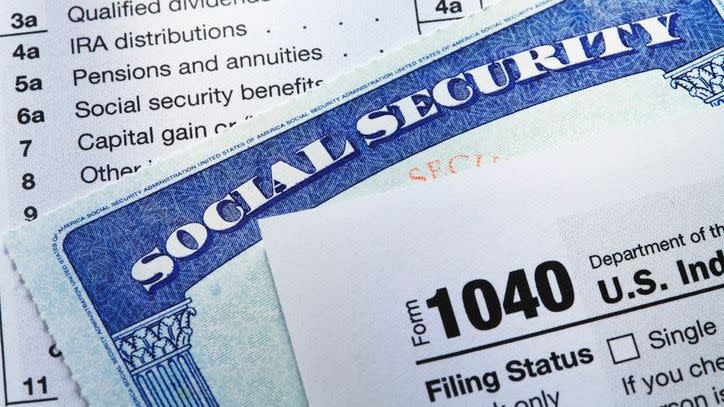Even though you’ve paid into Social Security throughout your working life, your retirement benefits aren’t necessarily tax-free income. In fact, up to 85% of your benefits are taxable, depending on your other sources of income. There are several strategies to manage and potentially reduce these taxes, including timing withdrawals from retirement accounts and using withdrawals from Roth accounts to pay for retirement expenses.
But what if you receive $2,100 in Social Security benefits each month? Do you have to pay taxes on those payments? The answer depends on whether and how much other income you have.
A financial advisor can provide you with personalized advice and help you create a plan to manage taxes in retirement. Contact a trustee advisor who is responsible for your region.
How social security benefits are taxed
Your total income, also called provisional income, determines whether your Social Security benefits are taxable. Calculate your total income by dividing your annual Social Security benefits in half and adding it to your adjusted gross income (AGI) from your tax return plus any tax-free interest you received.
After you calculate your total income, the taxation of your benefits depends on the amount of your total income and your tax status.
None of your benefits are taxable if your total income:
-
Less than $25,000 as an individual
-
Less than $32,000 if you are married and file a joint tax return
Up to 50% of your benefits are taxable if your total income:
-
More than $25,000 and less than $34,000 as an individual
-
More than $32,000 and less than $44,000 if you are married and file a joint tax return
Up to 85% of your benefits are taxable if your total income:
-
More than $34,000 as an individual
-
More than $44,000 if you are married and file a joint tax return
For example, a single person receiving the maximum monthly benefit of $4,873 in 2024 would have to pay taxes on up to 50% of their benefit, even if they had no other income. That’s because $4,873 monthly is equal to $58,476 annually. Half of that amount is $28,238, which is more than the $25,000 threshold for no taxation.
Using the IRS calculator, they were able to determine that $2,119 of their Social Security benefits would be taxable as ordinary income, taking into account the appropriate federal marginal tax rates. For 2024, the tax bracket on that income is 10%, so you would owe approximately $212.
If you need help with tax planning or determining the taxable portion of your Social Security income, consider working with a financial advisor.
Taxes on $2,100 in monthly Social Security benefits

If you receive $2,100 per month from Social Security, you probably wouldn’t have to worry about paying taxes on the money if it were your only source of income. Your total income would be just $12,600 ($25,200/2), which is below the threshold at which some of your benefits become subject to income tax.
However, let’s say you had additional income — say, $40,000 from 401(k) withdrawals. Your total income would be $52,600 ($40,000 + $12,600), meaning up to 85% of your Social Security benefits would be taxed as an individual. Using the IRS Interactive Tax Assistant calculator, you would see that $20,310 of your benefits would be subject to income tax.
Calculating your tax liability can be complex and confusing. This is where having an expert such as a tax advisor on your side can be helpful.
Tax strategies
There are several ways you can potentially reduce the taxes you owe on your Social Security benefits, but before you put any of these strategies into practice, you should talk to a financial advisor and explore possible alternatives.
-
Reduce your additional income. If you can reduce your extra income, for example by withdrawing less from tax-free IRA or 401(k) savings plans, you may be able to keep your total income below the tax-free threshold. In your case, for example, your benefits would only be subject to taxation if you had extra income of more than $12,400. That amount, along with $12,600 representing half of your Social Security benefits, keeps you from exceeding the $25,000 threshold for taxing Social Security benefits.
-
Withdrawing from Roth accountsQualified withdrawals from Roth accounts are not taxable and do not increase your overall income. By withdrawing from only one Roth account, you can avoid taxation on your Social Security benefits. Additionally, Roth accounts are not subject to required minimum distributions (RMDs) that might otherwise increase your overall income. You might consider converting tax-free accounts such as IRAs to Roth accounts, although you will have to pay taxes on the converted amounts as ordinary income.
-
Use cash or unappreciated investments. Using cash or selling investments that have not increased in value can help you pay your expenses without increasing your overall income.
-
Use qualified charitable donations (QCDs). If RMDs put you above the income threshold, you can reduce your RMDs through QCDs. These distributions allow you to give directly from your IRA to a charity, thereby lowering your taxable income.
Bottom line


At $2,100 a month, your Social Security benefits are not taxed unless you have enough extra income. If you file an individual tax return on your own, you can have up to $12,400 of extra income before your benefits become subject to income tax. Keep in mind that up to 85% of your Social Security can be taxable. Potentially helpful tax-reducing strategies include limiting withdrawals from tax-free retirement accounts, using Roth accounts, and selling unappreciated investments to generate cash to pay expenses.
Tips for social security planning
-
A financial advisor can help you plan for your Social Security benefits and incorporate those payments into a comprehensive retirement income plan. Finding a financial advisor doesn’t have to be hard. SmartAsset’s free tool matches you with up to three vetted financial advisors who serve your area, and you can have a free introductory call with your advisors to decide which one you think is right for you. If you’re ready to find an advisor who can help you reach your financial goals, get started now.
-
Knowing what your benefits might be at different eligibility ages is an important part of planning for Social Security. Fortunately, SmartAsset’s Social Security calculator can help you estimate your future benefits based on when you plan to take them.
Photo credits: ©iStock.com/Wasana Kunpol, ©iStock.com/DNY59, ©iStock.com/insta_photos
The post “I’m going to get $2,100 a month from Social Security. How can I lower my taxes?” appeared first on SmartReads by SmartAsset.
